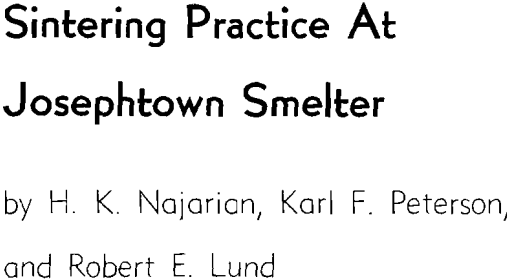Table of Contents
First, the relation between straight lime basic sinter’s susceptibility to disintegration and basicity was examined under various boundary conditions. Some selected results are shown in Figure 2: for variable fuel rates disintegration is governed by various influence factors: first, there is the well-known maximum as a function of basicity. More surprising is an additional effect: left and right of the maximum the values of disintegration fines are graduated, as expected, as a function of the preceding mechanical stress intensity (and hence of the variable fuel consumptions used in these tests). However, within the maximum disintegration range this graduation is not maintained but rather reversed. The disintegration values related to the higher fuel consumption (stabilisation by 70 revolutions in the ISO-tumbler) are higher than those established for a lower fuel consumption (20 revolutions), though higher hematite levels may be assumed for the latter.
For a constant mechanical treatment (20 revolutions), the disintegration values were classified in Figure 3 using the degree of oxidation as parameter. As the degree of oxidation increases, the curves are shifted towards higher disintegration values, while each single curve still continues to be a function of basicity. This Figure confirms most distinctly that while the oxidation degree is taken as an approximate measure of hematite content there are other influence factors which are of significance as well. In this context these factors are described by the term ‘basicity’. This statement is confirmed by the results of the mineralogical investigation described here under. While the disintegration fines (DF) were found to be a function of the total hematite content, as was expected:
DF (% – 0.5 mm) = 11.04 + 0.22 tot, hem. (%)…………………………..(1)
this relationship has a coefficient of determination of only 0.53; the scatter of the relevant pairs of values is considerable (the residual standard deviation of disintegration fines being say ± 3.9 %) Only by quantitative mineralogical investigations is it possible to determine the nature of these factors.
Accordingly, the fractions of the mineralogical phases were quantitatively determined for all the sinters. Depending on test procedure (test series) and mechanical stabilisation, different curve characteristics were established as a function of basicity for each of the identified phases, as exemplarily shown in Figure 4 for lime-basic sinters of series 1 and a mechanical treatment of 20 revolutions. The sinter of medium basicity is found here to be a mixture of acid and basic types of structure.
It may be concluded from this table that with increasing basicity the tendency to disintegretion at constant hematite level passes a maximum at p = 1.5.
The relation, here quantitatively determined for the first time, between disintegration and basicity for invariable hematite levels is evidently correlated with structural sinter characteristics. These, however, cannot be described by a quantitative determination of the phase constituents alone, therefore they were disregarded in sintering tests so far. Hence, there evidently are sinter structures of different susceptibility to disintegration.
Using series 2 as an example, Figure 9 shows susceptibility to cracking of sinter structures as a function of basicity, mechanical treatment and fuel rate. It will be seen that the highest crack frequency is indeed encountered in the sinters of medium basicity (i.e. in the most heterogeneous sinters).
Hence it follows that a relationship between disintegration and crack frequency may be expected, as was confirmed by statistical interpretation. For well sintered agglomerates (series 1, 70 revolutions), there is a distinct relationship (coefficient of determination 0.74 between number of short cracks and extent of low temperature disintegration:
DF (% – 0.5 mm) = -2.73 + 0.26 amount sh. cracks (%)……………………………(2)
The correlation between number of short cracks in a well sintered structure and its susceptibility to disintegration should, however, not be taken to mean that disintegration during low temperature reduction would be caused by the cracks as such. Extensive mineralogical investigations evidence that this is not the case. Local destruction of a hematite crystal in the sinter as e result of low temperature reduction is not predicated on its already being affected by cracks or located in the neighbourhood of crack-affected structural areas. Rather, hematite disintegration also starts in the very areas where defects in hematite are microscopically not detectable at all. Hence, it may be concluded that both low temperature disintegration and occurrence of short cracks result from the same structural conditions as characterized by (thermal) stress and assumed to be conditioned not least by the structure’s degree of homogeneity.
The close relationship between disintegration fines and total hematite content which governs these sinters, is shown in Figure 10a. It corresponds with the linear correlation:
DF (% – 0.5 mm) = 9.88 + 0.329 tot. hem. (%)……………………………….(3)
With a residual standard deviation of only 1.38% and a coefficient of determination of 0.71, this correlation is significantly more accurate than the correlation governing the fraction of primary hematite in Figure 10b (coefficient of determination = 0.38). This confirms that the hematite content of sinter has a substantial bearing on the disintegration behavior. In addition it becomes evident that the destruction takes place not only in a specific form of hematite, as had been assumed by other authors, but rather all forms of free hematite become affected by disintegration.
This result is almost exemplary in regard to present-day problems of producing sinter exhibiting both high strength properties (grain size, tumbler strength) and good disintegration behavior in conjunction with low overall fuel consumption rates. Both practices, i.e.
- increase in bed heights, and
- heat treatment of upper layers
are now successfully employed in modern sintering plants; better heat utilization thereby obtained leads to higher strength levels and/or to fuel savings while the sinter’s degree of oxidation (hematite or FeO content) remains practically unchanged. The consequences are shown in Figures 12 and 13: the results indicate that despite unaltered FeO levels and for same or higher strength levels such measures adversely affect the disintegration behavior.
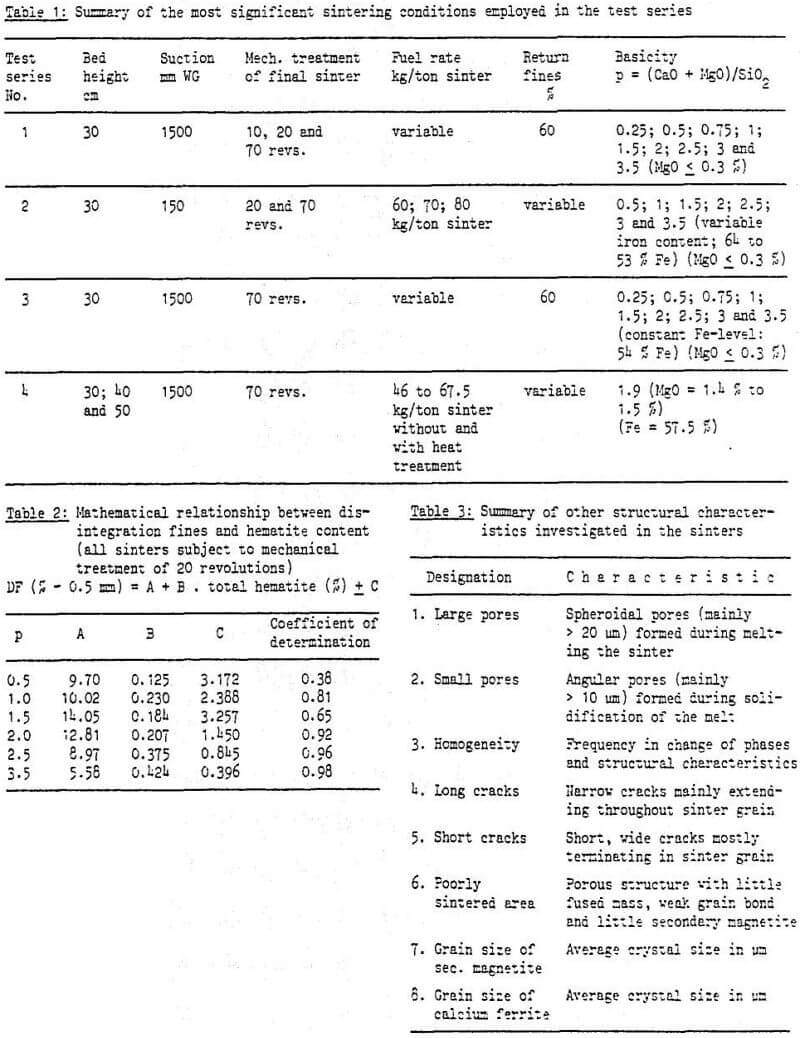
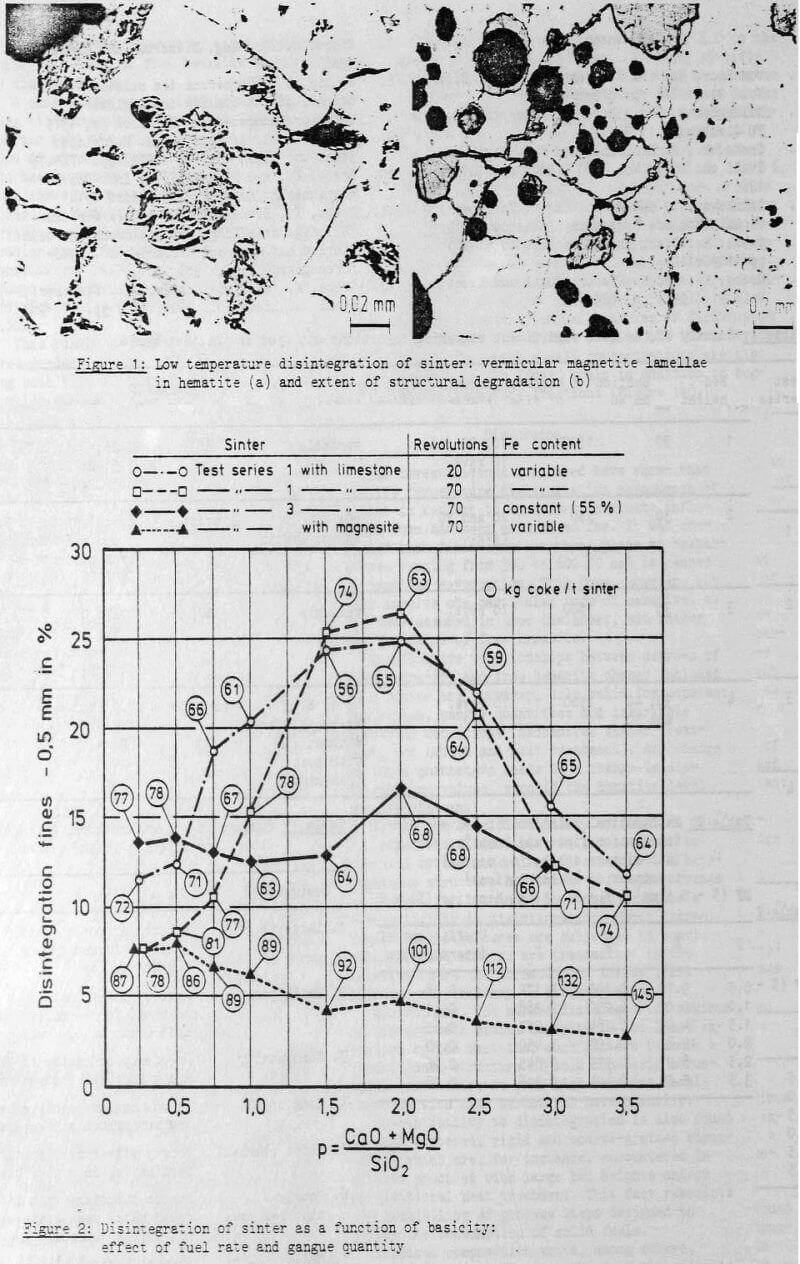
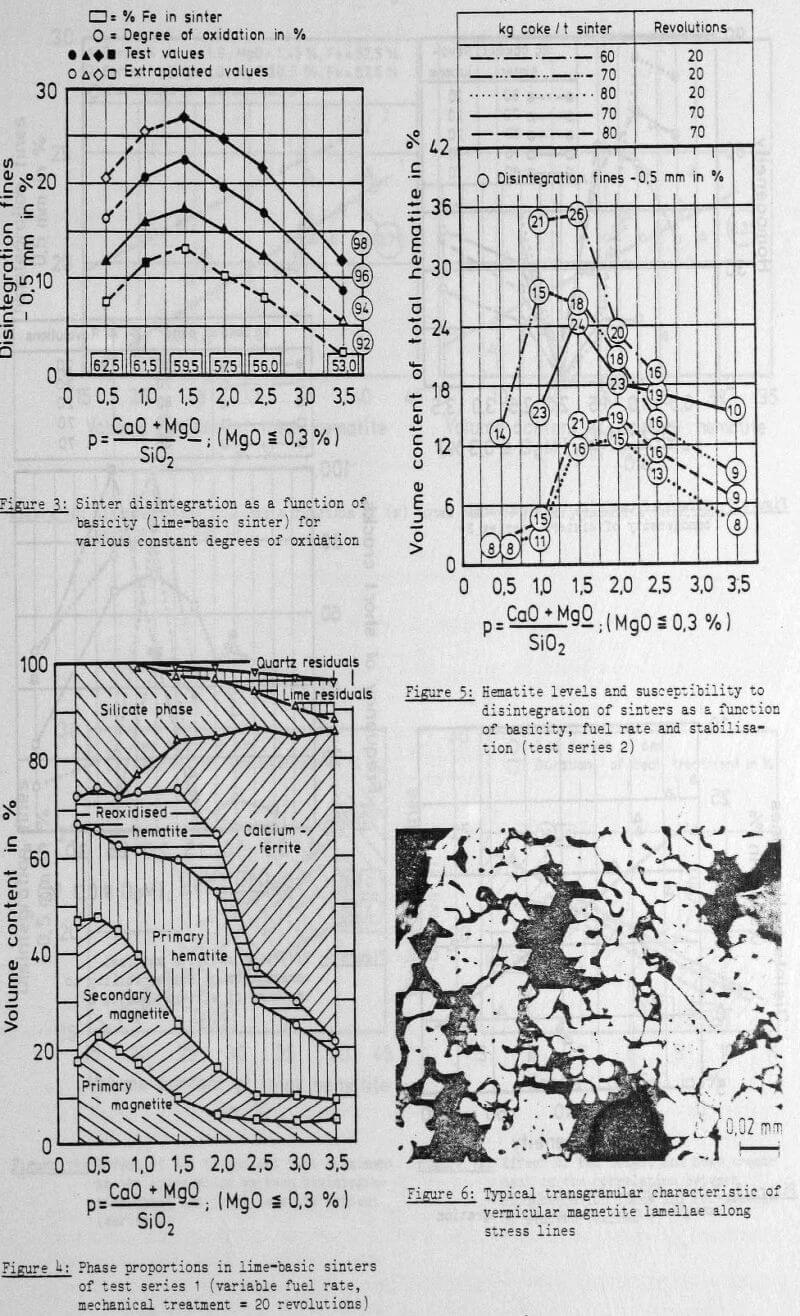
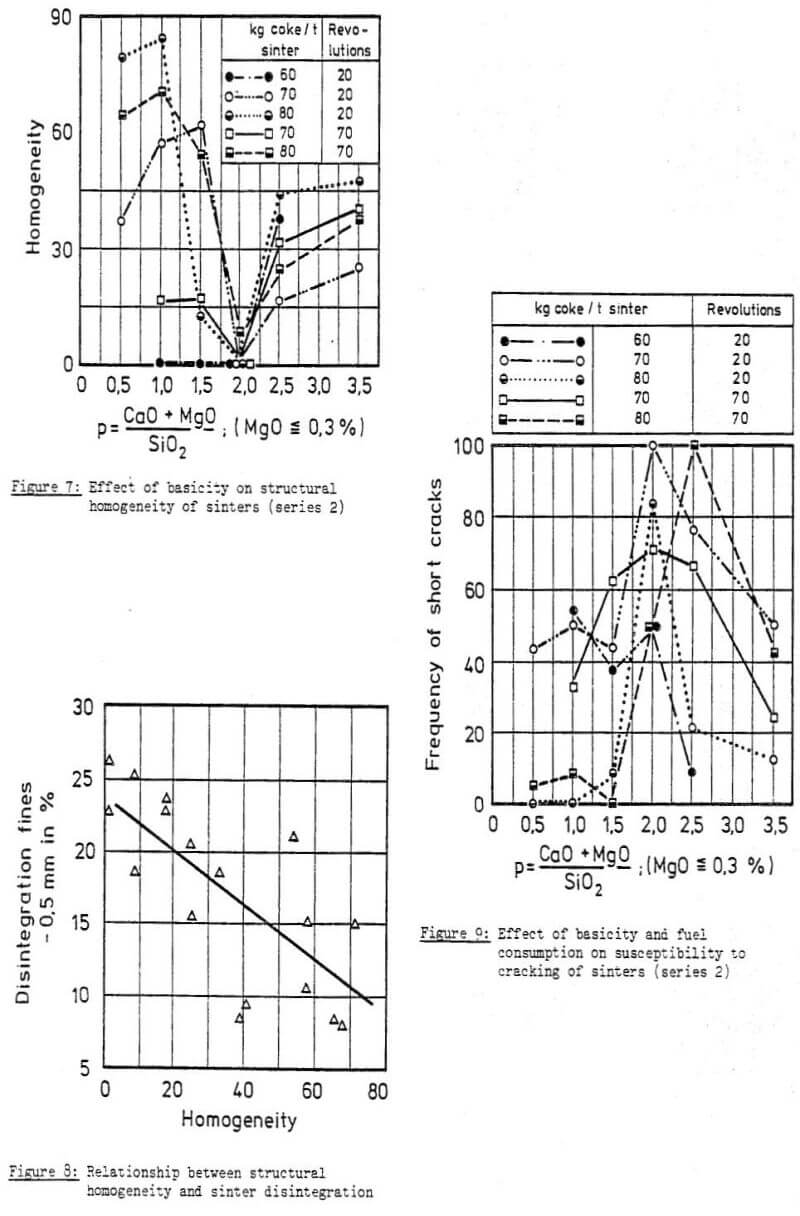
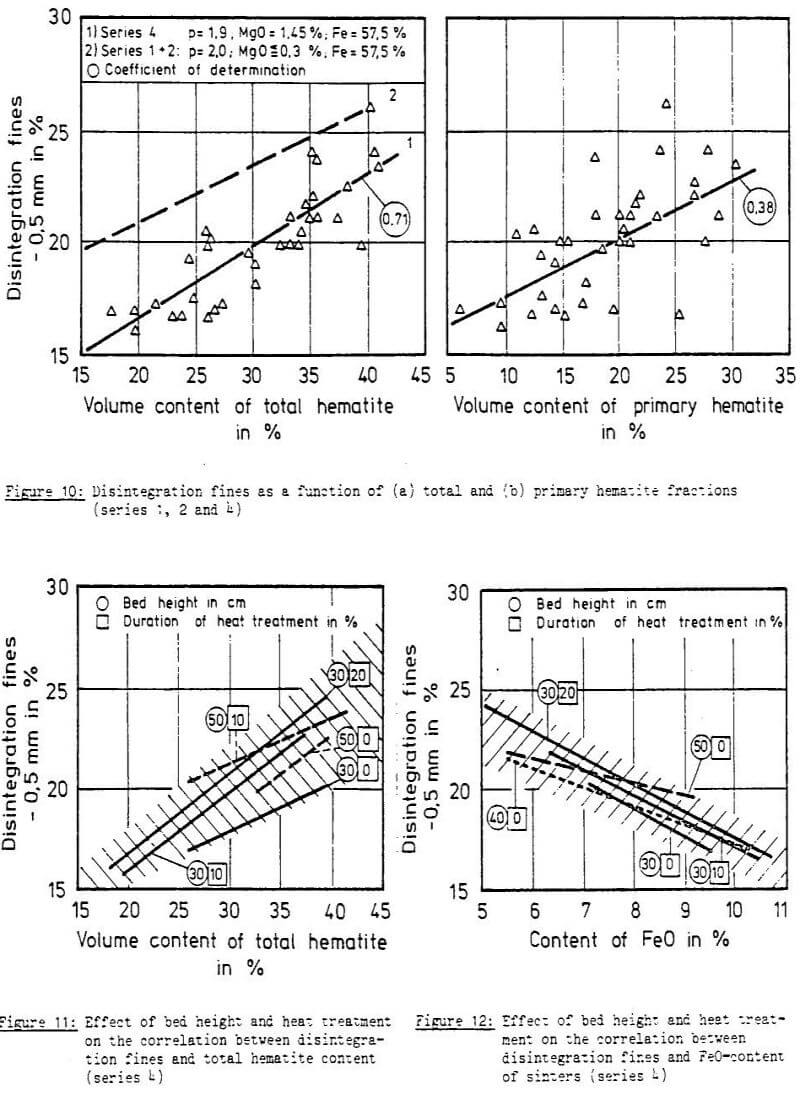
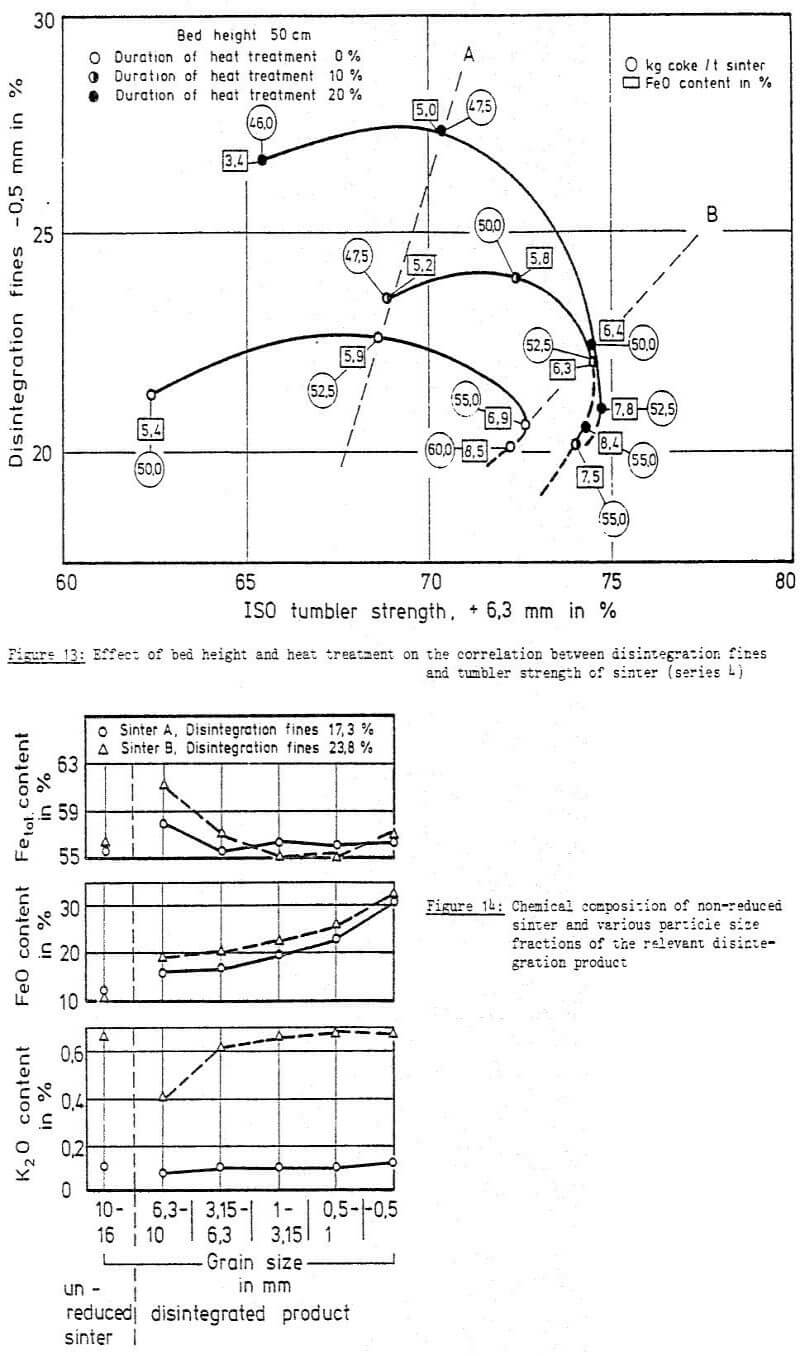

Primary products of the Josephtown smelter are zinc metal of various grades, lead-free zinc oxide pigments, cadmium metal, and sulphuric acid. Zinc concentrates of domestic and foreign origin are blended and desulphurized at the roaster plant. The equipment includes five, 12-hearth Herreshoff roasters and two modified Trail-type suspension roasters. The sulphur dioxide containing gases from the roasting operation are diverted to a four-unit contact acid plant for the manufacture of sulphuric acid. The roasted calcines are agglomerated by sintering on Dwight-Lloyd-type sintering machines; the sinter is crushed and sized within required limits; and the sized sinter is smelted in vertical shaft-type electrothermic furnaces. Of the 13 electrothermic furnaces of various sizes now in operation, four are designed to produce American process zinc oxide of various specifications; and the remaining nine furnaces are equipped with vacuum-type condensers and produce zinc metal. Papers describing the general smelting practice at Josephtown have been published by AIME.
Purification Theory
Partial elimination of lead and cadmium in the sintering of zinc ores is common knowledge. However, by some manipulation and by taking advantage of the double circuit, it is possible to make zinc sinter which is nearly free of contaminators. Lead and cadmium, both being more easily reduced with carbon than zinc and being quite volatile in the sulphide form, are driven ahead of the intensely hot burning zone in the sinter cake. On the soft sinter machines, the charge is quite refractory; therefore little slagging takes place during the burning of the charge. The top part of the bed is more nearly free of impurities than the bottom due to condensation of lead and cadmium compounds at the grate area.
It is important to have an open fast-burning charge and a high fusion point charge in order to get good elimination. Equally as important is a charge with the proper amount of fuel and moisture. Our experience has shown 4 to 4.6 pct coke is necessary with a calcine sulphur of from 1 to 3 pct.
Prime Western Sintering Circuit
The feed for the Prime Western sintering circuit comprises very fine suspension roaster calcines, —3/16 in. residues from the Prime Western furnaces, and dust collected in the Dracco collector from sinter, coke, residue, and furnace plants.
A typical charge going to the Prime Western machines is, in pounds per minute: calcine, 250; Dracco dust, 200; residue fines, 100; coke (—8 mesh), 50; sand (about 30 mesh), 8; and circulating return sinter, 1000.
All of these charge components are stored in steel storage feeder bins of adequate capacity. From the storage bins, calcines and Dracco dust are fed by screw feeders and the remaining components are fed by belt-type feeders on to a collecting screw conveyor which delivers it to an elevator discharging directly into a rotating pelletizer. The mixed charge contains about 4.4 pct coke fuel, part of which comes in through the Dracco dust and the residue fines.
In the pelletizer, the charge is moistened with water or dilute zinc sulphate solution by means of a pipe spray so designed that the solution is sprayed on the material during its entire passage through the pelletizer. The wetting solution is a byproduct of the leaching operations plus run-off water from Cottrell conditioning chambers.
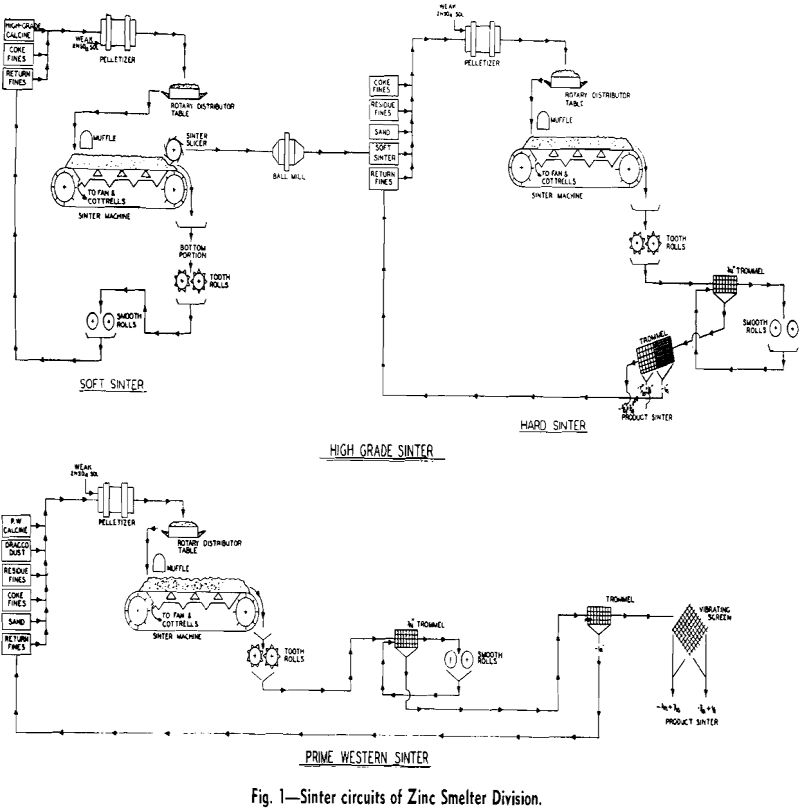
High Grade Sintering Circuit
Sintering in the High Grade circuit is in two separate steps. Low-lead calcine from the roasting plant is sintered first without the addition of silica sand to the charge. The resulting product is a soft, easily crushed sinter of high purity. The lead content is 0.005 pct or less, the cadmium content is 0.001 pct or less, and the sulphur content is 0.1 pct. The top half of the soft sinter cake containing the least amount of impurities is removed by means of a rotary slicer, mixed with silica sand, residues from furnaces using
Soft and Hard Sintering
A typical charge mix for soft sintering is: low-lead calcines (about 0.05 pct Pb), 400 lb per min; return sinter (crushed), 1000 lb per min; and coke (—8 mesh), 65 lb per min.
An 8 ft x 72 in. Allis Chalmers ball mill is being installed to grind the calcines to insure enough fines (35 to 40 pct —200 mesh) for proper pelletization of the mix. The return sinter is the bottom portion of the sinter cake crushed to —½ in.
The portion of the cake left on the pallet after removing the top is discharged onto a 36-in. pan conveyor which carries it to the 24×42 in. slugger rolls. The product of the slugger rolls, all —1 in., is transferred by means of a 24-in. pan conveyor to a 20 in. diam x 20 in. face smooth rolls set at 5/8-in. opening. The crushed product is conveyed by an elevator and 24-in. pan conveyor to the soft sinter “return fines” bin to be recirculated over the soft sinter machines.
Cottrells
An integral appendage to the sintering plant is the Cottrell installation for recovery of fume from the sintering machine gases. Sintering machine gases are discharged from the machine fans into large spray conditioning chambers for humidification prior to entering the Cottrells. Three separate Cottrell precipitators serve the sintering plant. Two precipitators, each rated at 100,000 cfm, receive gases from the hard sinter and soft sinter machines of the High Grade circuit. A precipitator of 150,000 cfm rating was installed to serve the Prime Western circuit with anticipation of expansion to include a third Dwight-Lloyd machine.
Cottrell precipitators were installed by Research Corp. and are of the rod-curtain type. Shell construction is of concrete with a 1-in. ceramic lining. Each precipitator comprises four sections, two in series and two in parallel. Each section in the 100,000 cfm precipitators consists of 21 ducts while the 150,000 cfm precipitator sections contain 27 ducts.
